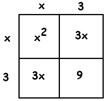The Astounding Power of Area
3.2 Level 0 and Level 1 Quadratics (and a taste of Level 2)
[This material appears in Section 2 of the full course on Quadratics.]
Let’s now explain the quadatus method for solving quadratic equations. We’ll start with quadratic equations that are overtly connected to squares and tweak our sophistication from there.
LEVEL 0 QUADRATIC EQUATIONS
Just a few examples should do it.
EXAMPLE: Solve \(x^{2}=100\).
Answer: Easy. \(x=10\) or \(x=-10\).
The only possible difficulty here is to remember that, in algebra, positive quantities have two square roots. (See the comment in lesson 2.1.)
EXAMPLE: Solve \(w^{2}=36\).
Answer: Easy. \(w=6\) or \(w=-6\).
EXAMPLE: Solve \(x^{2}=17\).
Answer: Okay, not as pretty but just as easy: \(x=\sqrt{17}\) or \(x= -\sqrt{17}\).
EXAMPLE: Solve \(x^{2}=0\).
Answer: Zero is the only number with just one square root. We have \( x=0\) .
EXERCISE 1: Solve:
a) \(x^{2}=121\).
b) \(p^{2} = 40\).
c) \(y^{2} + 5 = 14\).
d) \( 2x^{2} = 50\).
e) \(x^{2}=-6\).
EXERCISE 2: Leela was asked to solve \(x^{2}=1\). She wrote: \(x=\sqrt 1\) or \(x=-\sqrt 1 \). What do you think of her answer?
LEVEL 1 QUADRATIC EQUATIONS
Up a slight notch in trickiness.
EXAMPLE: Solve \((x+3)^{2}=100\).
Answer: This problem is saying “Something squared is \(100\). ” So the something must be \(10\) or \(-10\). That is:
\(x+3=10\) or \(x+3=-10\)
yielding
\(x=7\) or \(x=-13\).
EXAMPLE: Solve \((y-4)^{2} = 25\).
Answer: We have:
\(y-4=5\) or \(y-4=-5\)
yielding
\(y=9\) or \(y=-1\).
WARNING! Many like to answer these questions using the \(\pm\) symbol. But there is a potential danger as it is tempting to write the following:
\((y-4)^{2}=25\)
\(y-4=\pm 5\)
\(y=\pm 9\)
Do you see the danger? This is why I personally prefer to write things out and make sure I am thinking through everything carefully.
\(y-4=5\) or \(y-4 = -5\)
\(y=9\) or \(y=-1\)
This is now very clear and very correct. It never hurts to take an extra two seconds for the sake of clarity.
EXAMPLE: Solve \(4(p+2)^{2}-16=0\).
Answer: Add 16
\(4(p+2)^{2}=16\).
Divide though by 4
\((p+2)^2=4\)
to see
\(p+2=2\) or \(p+2=-2\).
This yields
\(p=0\) or \(p=-4\).
EXAMPLE: Solve \((x+7)^{2}+9=0\).
Answer: We have \((x+7)^{2}=-9\). In the system of real numbers, it is impossible for a quantity squared to be negative. This equation has no solution. (But if you like to work with complex numbers …)
EXAMPLE: Solve \((x-1)^{2}=5\).
Answer: We have
\(x-1=\sqrt 5\) or \(x-1=-\sqrt 5\)
so
\(x=1+\sqrt 5\) or \(x=1-\sqrt 5\).
EXAMPLE: Solve \((x+3)^{2}=49\).
Answer: We have
\(x+3=7\) or \(x+3=-7\)
yielding
\(x=4\) or \(x=-10\).
EXERCISE 3: Solve.
a) \((x-1)^{2}=64\)
b) \((p-3)^{2}=16\)
c) \((y+1)^{2}-2=23\)
d) \(3(x-900)^{2}=300\)
e) \((x-\sqrt 2)^{2}=5\)
EXERCISE 4:
a) How many solutions does \((x+7)^{2}=0\) possess? What are they?
b) How many solutions does \((x+7)^{2}=-2\) have? What are they?
LEVEL 2 QUADRATICS
Here’s a conceptual leap!
EXAMPLE: Solve \(x^{2} + 6x+9=49\).
Answer: If one is extremely clever one might realize that this is a repeat of the example \(\left(x+3\right)^{2}=49\) we just did: the quantity \(x^{2} + 6x+9=49\) happens to equal \((x+3)^{2}\).
To check this, work out \((x+3) \times (x+3)\) as the area of a square divided into four pieces to see it is \(x^{2} + 6x+9=49\) in disguise.

So the challenge
Solve \(x^{2} + 6x+9=49\)
is indeed the previous example
Solve \((x+3)^{2} =49\)
in disguise. We have:
\(x+3=7\) or \(x+3=-7\)
\(x=4\) or \(x=-10\).
The challenge in level 2 is to recognize more complicated expressions as easy level 1 problems in disguise.
We’ll do this next.
Resources
Books
Take your understanding to the next level with easy to understand books by James Tanton.
BROWSE BOOKS![]()
Guides & Solutions
Dive deeper into key topics through detailed, easy to follow guides and solution sets.
BROWSE GUIDES![]()
Donations
Consider supporting G'Day Math! with a donation, of any amount.
Your support is so much appreciated and enables the continued creation of great course content. Thanks!
Ready to Help?
Donations can be made via PayPal and major credit cards. A PayPal account is not required. Many thanks!
DONATE![]()


